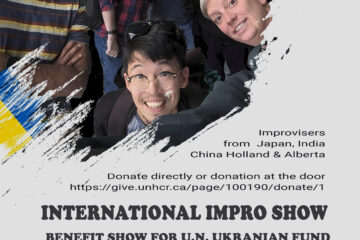THOUGHTS, IDEAS, QUESTIONS, PROCESS, LESSONS,
Student Post
YATTA – WKATTA – TSUGI
OSHOW – Week 4
Week 4
Two of the class members were out sick, so this week the class consisted mainly of three members.
It was a more concentrated practice, but there was a sense of sadness. It is a bit depressing to be twithout the friends who have been with us for so long.
For this week’s review, I will use the “YWT method,” which is a method used by Japan Management Association Consulting (JMAC) in which:
- Y stands for -Yatta- what I did,
- W for -Wkatta- what I found out, and
- T for -Tsugi- what I will do next.
There is a similar “KPT method” (Keep, Problem, Try), but I prefer the YMT method because it seems to focus on the process rather than the results. ーーー
Y: What I did –
- -I went to see Rapid Fire Theatre in Edmonton.
- -I did storytelling in both English and Japanese at the sametime.
- -I tried to be specific in my storytelling, such as naming names and saying details in a scene.
- -I provided remote training through an online connection with a studio in Japan.
- -I did “What comes next?” to create a long scene.
- -I left the oil heater on and went out (this is something of a mistake rather than something I did).
W: What I found out –
You can tell if a player is good or poor by the way he or she stands. Poor players make themselves look bigger or smaller than they need to. I think there is more fear and anxiety at the root of this than necessary.
Good players, on the other hand, are neutral. They may have fears and anxieties, but they don’t try to hide them. They seem to be with them and share with us. They have the flexibility to be both storyteller and clown.
-Education of the audience is important.
When one of the RFT shows, “Scratch,” had an audience member make a silly suggestion about “orgasms,” a player said, “I can do that, but it’s not the show to do that!“
I was impressed by what he said. Players who want a laugh tend to accept silly suggestions. But by doing so, they educate the audience that this is a show where silliness is important.
-It was good to see that the players were open to confusion in RFT’s impro musicals.
Impro always comes with a meta perspective, but they made the most of it in a positive way. I was glad to see that the players were open about it when they got confused.
-RFT has a solid foundation of narrative impro, as the company was originally directed by Keith’s student, Patti Stiles (one of my favorite teachers), who was the artistic director of the company. And on top of that, each of them is trying various styles of performance. They are not stuck in the old or existing styles. I feel that they are always thinking, “What kind of challenges can we take on?”.
Loose Moose, on the other hand, is the image of good old traditional theater. It is important to have that, but I think it is also important for players to actively take on challenges.
In Japan, I have the impression that mid-career players are actively taking on challenges. In order to share this with young people, it is necessary to have a place to develop the foundation.
-I feel at ease by putting myself in Japanese. If I impose on myself, “I have to speak English!”, I feel pressured. But it is easier if I can let go and say, “Speak Japanese whenever you want!”.
This is the embodiment of what Shawn says, “Take care of yourself first”. I want to use this sense in my Japanese shows as well.
-By being specific, it becomes easier to understand what is required in the story. And it doesn’t have to be something trivial. It doesn’t have to be important. All you need to say is who your friend is and what the gift is and so on. And that is important training for Japanese because we usually don’t use subjects. Sometimes we don’t even know the name of the person until the end of the long form. Culturally, it may be possible to do that, but it is more an issue of limiting the possibilities of the story.
-This was my first time doing remote instruction, and I found it to be quite useful: in a Zoom class, we are each in a box, so we are limited in what we can do. But in this one, we can work as close to face-to-face as possible, especially for scene work divided between customers and players.
-The focus on specific actions, rather than vague results, makes the story more interesting. “What comes next?” “I’m going to the beach.” “What comes next?” “I go fishing,” etc. Focus on specific actions as a process, such as “take out the fishing rod” “put a palm-sized shrimp on the fishing line” “swing as hard as you can” “throw the shrimp the furthest you’ve ever thrown it” etc. In this way, you can create a concrete image of the story one by one. It does not become a vague one. The key is details and action.
-The long scene and the short scene are essentially the same thing to do. You just need to go on at a place where it would be an ending. Keith says, “When you die, go to heaven”. With that in mind, you can go on forever: the story after 10 years, the story of the offspring, the story in heaven, and so on.
You don’t have to put off the story just because it’s long.
-Improv goes on like a manga, not a movie.
The key to a good manga is to draw panels that draw you in at every moment. And it ends with the most interesting panels at the end of the episode. The ideal storytelling, whether long or short, is one that engages you moment by moment, and then you find yourself at the end of the episode.
***BTW, the manga I recommend is “Bokutachi ga Yarimashita” (“We Did It” but no English ver). I think the original story writer, Muneyuki Kaneshiro (“Blue Rock,” “As God Says,” etc.) is a genius storyteller, because always at the end of an episode, the character’s least desired thing happens. Other than that, there are many other great Japanese manga such as “Oshi No Ko,” “Beasters,” and “Phoenix,” just to name a few.
T: What I will do next
-Provide a place where young improvisers can develop a foundation. Classes and shows where they can learn and experience. I want to encourage an active exchange of knowledge and experience.
-Learn Impro Musicals. Impro musicals have a lot of potential, but they have not developed to that extent in Japan. It is necessary to develop improvisers who can do musicals and musical actors who can do impro at the same time, and strong teachers are needed for this purpose. Perhaps it is still necessary for me, who has experience performing in musicals, to actively lead the way. I need to gain the knowledge and experience to do so…I hear BATS is having a workshop soon. Maybe I should jump in.
-I can do a remote class with an overseas instructor from a studio in Japan, or I can connect with a studio in another prefecture or country to give classes. Might not be possible right now, but the possibilities are endless.
-I will try to see if I can create a long scene with Keith’s storytelling. The reason I don’t write “Long Form” is to differentiate it from Chicago style. Perhaps that is what Full-Length Impro is all about.
-I want to be an improviser who can always live for the people around me, even in everyday life. But don’t forget to take care of myself. Contribution and self-sacrifice are similar but totally different. I always want to be happy and healthy.
Translated with
(free version)




0 Comments